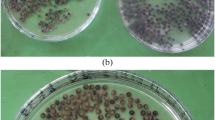Abstract
Because chromosomal homologues segregate from one another during meiosis, spermatids are genetically different. Post-meiotic gene expression could lead to gametic differences, some of which might lead to preferential transmission of certain alleles over others. In both insects and mammals, however, all the cells derived from a single spermatogonial cell develop within a common syncytium formed as a result of incomplete cytokinesis at each of the mitotic and meiotic cell divisions1–3. It has been proposed that the intercellular bridges connecting the cells, which are about 1 μm in diameter4, permit the sharing of cytoplasmic constituents, thus ensuring the synchronous development of a clone of cells and gametic equivalence between haploid spermatids2,5,6. By analysing the product of a transgene which is expressed exclusively in post-meiotic germ cells in hemizygous transgenic mice, we have shown that genetically distinct spermatids share the product of the trans-gene and hence can be phenotypically equivalent.
Similar content being viewed by others
References
Burgos, M. H. & Fawcett, D. W. J. biophys. biochem. Cytol. 1, 287–300 (1955).
Fawcett, D. W. & Burgos, M. H. Ciba Fdn Symp. 2, 86–96 (1956).
Phillips, D. M. J. Cell Biol. 44, 243–247 (1970).
Dym, M. & Fawcett, D. W. Biol. Reprod. 4, 195–215 (1971).
Fawcett, D. W., Ito, S. & Slautterback, D. J. biophys. biochem. Cytol. 5, 453–460 (1959).
Erickson, R. P. Nature new Biol. 243, 210–212 (1973).
Hecht, N. B., Bower, P. A., Waters, S. H., Yelick, P. C. & Distel, R. J. Expl Cell Res. 164, 183–190 (1986).
Peschon, J. J., Behringer, R. R., Brinster, R. L. & Palmiter, R. D. Proc. natn. Acad. Sci. U.S.A. 84, 5316–5319 (1987).
Oakberg, E. F. Am. J. Anat. 99, 391–413 (1956).
Nebel, B. R., Amarose, A. P. & Hackett, E. M. Science 134, 832–833 (1961).
Dooher, G. B. & Bennett, D. Am. J. Anat. 136, 339–362 (1973).
Fawcett, D. W., Anderson, W. A. & Phillips, D. M. Devl Biol. 26, 220–251 (1971).
Fawcett, D. W. in The Functional Anatomy of the Spermatozoon (ed. Afzelius, B. A.) 199–210 (Permagon, Oxford, 1975).
Erickson, R. P. Fedn Proc. 37, 2517–2521 (1978).
Clermont, Y. & Rambourg, A. Am. J. Anat. 151, 191–212 (1978).
Handel, M. A. in Results and Problems in Cell Differentiation (ed. Hennig, W.) 1–62 (Springer, Berlin, 1987).
Frischauf, A. M. Trends Genet. 1, 100–103 (1985).
Silver, L. M. A. Rev. Genet. 19, 179–208 (1985).
Olds-Clarke, P. Gamete Res. 20, 241–264 (1988).
Bellve, A. R. in Oxford Reviews of Reproductive Biology vol. 1 (ed. Finn, C. A.) 159–261 (Oxford University Press, London, 1979).
Hecht, N. B. in Experimental Approaches to Mammalian Embryonic Development (ed Rossant, J. & Pedersen, R. A.) 151–193 (Cambridge University Press, New York, 1986).
Brinster, R. L., Chen, H. Y., Trumbauer, M. E., Yagle, M. K. & Palmiter, R. D. Proc. natn. Acad. Sci. U.S.A. 82, 4438–4432 (1985).
Mutter, G. L. & Wolgemuth, D. J. Proc. natn. Acad. Sci. U.S.A. 84, 5301–5305 (1987).
Bellve, A. R. et al. J. Cell Biol. 74, 68–85 (1977).
Author information
Authors and Affiliations
Rights and permissions
About this article
Cite this article
Braun, R., Behringer, R., Peschon, J. et al. Genetically haploid spermatids are phenotypically diploid. Nature 337, 373–376 (1989). https://doi.org/10.1038/337373a0
Received:
Accepted:
Issue Date:
DOI: https://doi.org/10.1038/337373a0
- Springer Nature Limited
This article is cited by
-
Identification and selection of healthy spermatozoa in heterozygous carriers of the Phe508del-variant of the CFTR-gene in assisted reproduction
Scientific Reports (2022)
-
Soma-to-germline RNA communication
Nature Reviews Genetics (2022)
-
Mutagenesis alters sperm swimming velocity in Astyanax cave fish
Scientific Reports (2022)
-
Genetically-biased fertilization in APOBEC1 complementation factor (A1cf) mutant mice
Scientific Reports (2022)
-
Communal living: the role of polyploidy and syncytia in tissue biology
Chromosome Research (2021)





